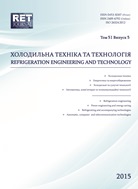COMPARATIVE FIELD EXPERIMENTAL INVESTIGATIONS OF DIFFERENT FLAT PLATE SOLAR COLLECTORS
DOI :
https://doi.org/10.15673/0453-8307.6/2015.56708Mots-clés :
Solar collector, Test rig, Hot water supply system, Polymeric materialsRésumé
Full-scale traditional metal solar collectors and solar collector specimens fabricated from polymeric materials were investigated in the present study. A polymeric collector is 67.8% lighter than a traditional metal solar collector, and a metal solar collector with transparent plastic covering is 40.3% lighter than a traditional metal solar collector. Honeycomb multichannel plates made from polycarbonate were chosen to create a polymeric solar collector. A test rig for the natural circulation of the working fluid in a solar collector was built for a comparative experimental investigation of various solar collectors operating at ambient conditions. It was shown experimentally that the efficiency of a polymeric collector is 8–15% lower than the efficiency of a traditional collector.Références
Chen, K., Oh, S.J., Kim, N.J., Lee, Y.J., Chun, W.G., 2010. Fabrication and testing of a non-glass vacuum-tube collector for solar energy utilization, Energy 35, 2674–2680. 2. Cristofari, C., Notton, G., Poggi, P., Louche, A., 2002. Modelling and performance of a copolymer solar water heating collector, Solar Energy 2, 99–112. 3. Doroshenko, A.V., Glauberman, M.A., 2012. Alternative energy. Refrigerating and Heating Systems, Odessa I.I. Mechnicov National University Press, Odessa, Ukraine. ISBN 978-617-689-015-7. 4. Garcıa-Valladares, O., Pilatowsky, I., Ruız, V., 2008. Outdoor test method to determine the thermal behavior of solar domestic water heating systems, Solar Energy 82, 613–622. 5. Goedkoop, M., Effting, S., Collignon, M., 2000. The Eco-indicator 99. A damage oriented method for Life Cycle Impact Assessment. Second edition, Amersfoort. 6. Hamed, M., Fellah, A., Brahim, A., 2014. Parametric sensitivity studies on the performance of a flat plate solar collector in transient behavior, Energy Conversion and Management 78, 938–947. 7. Hayek, M., Assaf, J., Lteif, W., 2011. Experimental investigation of the performance of evacuated-tube solar collectors under eastern Mediterranean climatic conditions, Energy Procedia 6, 618–626. 8. IEA SHC Task 39. Polymeric materials for solar thermal solar application. In: Highlights from 2010 paper for Task 39 of the Solar Heating and Cooling Programme of the International Energy. <http://www.iea-shc.org/task39>. 9. ISO14040/44, Environmental Management – Life Cycle Assessment – Principles and Framework / Envi-ronmental Management - Life Cycle Assessment - Requirements and Guidelines, 2006. 10. Koehl, M., Saile, S., Piekarczyk, A., Fischer, S., 2014. Task 39 Exhibition – Assembly of Polymeric Com-ponents for a New Generation of Solar Thermal Energy Systems, Energy Procedia, 48, 130–136. 11. Koltun, P., Tharumarajah, A. Environmental Assessment of Small Scale Solar Thermal Electricity Generation Unit Based on LCA Study. In: Proc. of 15th International Conference on Life Cycle Engineering, Sydney, Australia, 2008. 12. Ladener, H., Späte, F., 2008. Solaranlagen: Das Handbuch der thermischen Solarenergienutzung. Ökobuch-Verlag, Staufen. ISBN 978-3-936896-40-4. 13. Lindeijr, E. Valuation in LCA. IVAM Environmental Research, Amsterdam, 1995. 14. Martinopoulos, G., Missirlis, D., Tsilingiridis, G., Yakinthos, K., Kyriakis, N., 2010. CFD modeling of a polymer solar collector, Renewable Energy 35, 1499–1508. 15. Nielsen, J.E., Bezzel, E., 1997. "Duct Plate" Solar Collectors in plastic materials. In: Proc. of 7th International conference on solar energy at high latitudes North Sun '97, Espoo-Otaniemi, Finland, 571-579. 16. Olivares, A., Rekstad, J., Meir, M., Kahlen, S., Wallner, G., 2008. A test procedure for extruded polymeric solar thermal absorbers, Solar Energy Materials & Solar Cells 92, 445–452. 17. Raman, R., Mantell, S., Davidson, J., Wu, C., Jorgensen, G., 2000. A review of polymer materials for solar water heating systems, Trans. ASME. J. Sol. Energy Eng 122, 92-100. 18. Rojas, D., Beermann, J., Klein, S.A., Reindl, D.T., 2008. Thermal performance testing of flat-plate collectors, Solar Energy 82, 746–757 19. Sandnes, B., Rekstad, J., 2002. A photovoltaic/thermal (PV/T) collector with a polymer absorber plate. Experimental study and analytical model, Solar Energy 72, 63–73. 20. SimaPro - 7.0, LCA Software, Pre Consultants, The Netherlands, 2007. 21. Tang, R., Cheng, Y., Wu, M., Li, Z., Yu, Y., 2010. Experimental and modeling studies on thermosiphon domestic solar water heaters with flat-plate collectors at clear nights, Energy Conversion and Management 51, 2548–2556. 22. World Aluminium, 2013. Global life cycle inventory data for the primary aluminium industry. International Aluminium Institute, London, UK 23. Xiao, F., Yi-Nian, C., Li-Lun, Q., 1998. A new performance criterion for cogeneration system, Energy Conversion and Management 39, 1607-1609.


